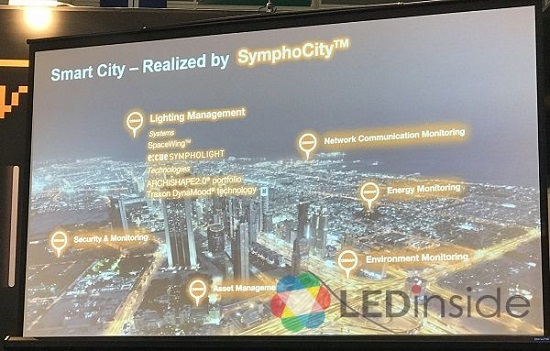Smart lighting is playing a pivotal role in unlocking the power of the IoT and smart building applications beyond lighting. An intelligent, sensor-laden lighting system can form the central nervous system of a building, enabling smart lighting and other current and future IoT applications.
 |
|
(Image: LEDinside) |
A smart lighting solution uses a combination of technologies to support data-driven automated solutions:
-
LED technology enables luminaires to become digital data nodes on the lighting system network. This means that LEDs can send information and receive commands from software or other digital devices on the network.
-
Sensors detect some type of event or change in the physical environment such as light, temperature or motion. They are an integral part of the lighting system that feeds data to a central control system.
-
Software enables control and automation based on different variables within the space.
-
Historical and real time data is stored and analyzed so that adjustments can be made and greater efficiencies can be realized.
-
A network connects it all together.
Lighting is ubiquitous. There are luminaires in every corner of every building that can house sensors for capturing data about the space. The combination of technologies and location ubiquity makes the infrastructure of an intelligent lighting system the perfect platform for enabling smart building-related IoT applications.
Getting Started With IoT
Selecting an infrastructure that will support the IoT can be an overwhelming task. There are still many unknowns about what the exact requirements will be and no one wants to make an investment mistake.
Here are 5 fundamental tips when choosing an intelligent lighting system infrastructure as your platform for IoT:
1. Be Prepared to Scale
Choose a software-based, scalable infrastructure that can grow in size and scope, protecting and extending the value of your investment. Software is easy and cost-effective to upgrade, and you will not need to rip out and replace expensive hardware as you grow. A scalable infrastructure empowers you with the freedom and peace of mind that comes with knowing you have the right foundation to support more features and functionality when needed.
2. Stay Flexible and Agile
Choose an infrastructure that not only supports change, but supports change quickly. Most office space is reconfigured regularly to accommodate people movement and space adjustments. As you reconfigure space and/or move people, chances are you will need to adjust lighting and other smart building applications as well. Select an infrastructure that offers great flexibility independent of any hard-wired electrical circuitry. You’ll want to adjust luminaires and control zones quickly with a few mouse clicks and without re-wiring or moving fixtures.
A flexible infrastructure supports any luminaire on the market and individual addressability of these luminaires. Why reduce your choice of luminaire with so many options out there? Pick the right luminaire for the space. And, individual addressability of each luminaire will enable you to capture granular data that will be needed for emerging smart building IoT applications such as predictive maintenance. Facility managers will need the greatest level of flexibility managing every corner of the building as new applications are added to their space.
3. Go Wireless
Select a wireless system or a hybrid system that supports a combination of wireless and wired. Wireless technology has improved drastically over the past five years and it will continue to improve moving forward. In the not so distant future, virtually everything will be wireless including emerging IoT applications that will make your smart building even smarter, so be prepared. The initial technical challenges of deploying wireless have been overcome and now wireless is the connectivity of choice because it costs less, it is more flexible than hard-wired systems, and can be deployed quickly.
4. Stick with Non-proprietary
A standards-based, non-proprietary platform is key to enabling the variety and number of potential IoT applications that will surface, including those from start-ups. The IoT will be based on the latest innovations and technologies as well as partnerships and alliances with each organization contributing their area of expertise for a complete solution. Access to a broad ecosystem fundamentally conflicts with a proprietary platform strategy. You don’t want your options to be limited when considering specific IoT applications.
The platform also needs the capability to connect to the cloud for data storage and SaaS-based (software-as-a-service) applications such as space utilization, asset tracking, conference room and desk bookings, and more. Open, cloud-connected platforms and tools enable more developers to deliver more innovative apps quickly and cost-effectively.
5. Make the Experience User-Friendly
Choose a system that is easy-to-use for both the facility manager as well as occupants. Additional features and functionality should not translate to additional complexity for facility managers and their operations team. As smart systems evolve, facility managers will be putting more control of the environment into the hands of occupants to support their preferences in their workspaces. A simple user experience is crucial to making the facility team’s tasks easier and not more complex.
Imagine the Possibilities
IoT brings smart lighting to the next level. Think of it as smart lighting on steroids. While smart lighting is able to bring efficiencies and automation to the lighting system, the addition of IoT tells a broader story about the space, the occupants, and the building itself.












